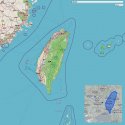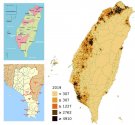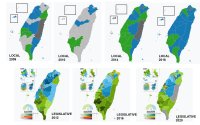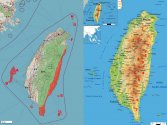So I was thinking about Taiwan recently and...wait... what? Singapore? Indonesia? Han in Malaysia?

As I was saying... my three cents on:
PRC's contingency response to Taiwan's de facto declaration of independence in the mid 2020s.
The specifics are important as any Mainland-initiated military action has better options. The images below are thumbnails.
1. Theatre of operations

This is Republic of China (Taiwan) with the exception of Pratas Island and Taiping Island in the Spratlys Archipelago. In this scenario I assume that Taiwanese declaration of independence retains claim to all the territory currently within jurisdiction of Taipei. It is not a valid claim and in itself will present a separate legal case for intervention as Kinmen and Matsu may lay counter-claims. In the bottom right corner Taiwan is superimposed over Donbas region for comparison of the spatial extent of operations. However the population of Donbas is about 1/5 to 1/4 of that of Taiwan (23m).
2. Population distribution

Population is the factor that needs to be controlled and the only factor over which the US has a viable claim in its own sphere of influence. To achieve victory in shortest time possible Taiwan needs to be controlled with the lowest possible number of people under direct control of invading PRC forces.
The east coast has the lowest density as well as total of population of all the non-mountainous areas of the island. In the bottom left corner I indicated populations of the respective counties in the most important landing zone near Hengchun. The area is approximately 25km wide and 40km long and has less than 100k people living in one medium city and several small towns and villages along the coast. It is the most important location as it enables secure transit through the Luzon Strait for PLAN.
3. Political division

The results of local elections indicate chosen mayors/magistrates. The results of legislative elections indicate Legislative Yuan delegates. After the period of DPP dominance the region slowly leans back toward independent candidates which are always best options for collaboration. It is also important to remember that a
binary system can be harmonized to retain control (this is the purpose of two-party pseudodemocracies - to exert one-party control while presenting a superficial electoral choice to the population) but
trinary systems are inherently chaotic an the side with the greater brute-force computing capability will be able to better predict outcomes for optimal planning or brute force them through other means (financial etc).
4. Proposed solution
Usually when an invasion scenario is imagined it involves a cross-strait assault with the attack focusing on the western coast. This is the island's geography heavily favours a flaking maneuver - that is an assault on the eastern coast and the adjacent islands.
As the
primary aim of all military operations on Taiwan is effective de-escalation achieved in shortest possible amount of time the benefit of such operation is clear:
- Establishment of A2/AD assets on the eastern coast to physically cut off Taiwan from allies as well as - crucially, as demonstrated in the Russian invasion of Ukraine - information sources. China needs to erect a physical wall of interference between Taiwanese forces and US and Japan to disrupt the former's ability to acquire sufficient battlespace awareness.
- Valid political claim of recapturing Taiwan as domestic parameters for victory conditions don't involve eliminating all "pockets of resistance". In physical terms China only needs Taiwan to the extent that UK needs Cyprus - to facilitate sea and air control. In political terms an "Republic of Taiwan" government in exile can exist and will exist as the US will establish one as soon as it is necessary. As long as physical security of the island is not disrupted it is not a significant problem.
- Enabling full spectrum of operations to be employed against Taiwanese forces as opposed to just aerial and amphibious assaults. This also allows for greater flexibility in planning since land-based forces do not have the same constraints as sea-based forces. It allows for repeated freeze/thaw cycle to be employed and used to divide local authorities and military.
- Enabling a defensive tactical posture which makes it more difficult for Taiwanese defenders since it requires them to change the preferred tactic and go on the offensive.
5. Necessary area of control

Red indicates the areas that need to be put under PRC control for de-escalation to become military viable.
Letters A-H denote the adjacent islands which are captured as staging grounds and outposts and as facilitators of the blockade. Numbers 1-7 denote roads linking east and west coasts. From what I've found in public sources there are only those seven roads linking both parts of the island. Blocking them off effectively prevents any reinforcements to be sent to counter the landing forces. What's important any disruption of transit needs only to be temporary. It can be achieved by something as simple as timed mines deployed by cluster warheads in missiles. The time necessary is between 24 and 72 hours. Once the areas in red are secured and naval task forces are deployed to support them negotiations on Taiwan's surrender can commence.
This scenario has a minimum requirement of 10 amphibious/aerial battlegroups - 7 for securing the roads numbered 1-7 and three for captue/controlling of main population centers - Hualien, Taitung and Hengchun. Interestingly it seems that none of the battlegroups needs to exceed 2000 soldiers in its initial stage which means that those assaults can
in theory be performed with the currently developed amphibious assets and require only minimal expansion of airborne capacity. Specifically from my initial estimate (which might be wrong) for viability it needs just:
- 3 Type 075 (Hualien, Taitung, Hengchun)
- 10 Type 071 (1, Hualien, 2, 3, 4, 5, Taitung, 6, 7, Hengchun)
- 24 072A and 072III (2-3 at each location)
- special forces and aerial assaults supporting air/amphibious landings
Naturally
this scenario assumes a sufficient mobilized response prepared in advance to support these and other landings.
And that leaves me thinking if it is just a coincidence or did I accidentally follow PLA's contingency thinking since this is where the amphibious capabilities seem to have converged at the moment. Obviously there are practical implications to training, skill development etc and they are under three separate Fleets but also it just so happens that this is
the exact number of assets necessary for this exact plan while PLAN is busy preparing for a larger leap in capabilities in the near future... but not before the end of 2020s.
Am I just imagining things? Or did I just walk in on the PLAN commander and his mistress in the storage room?





